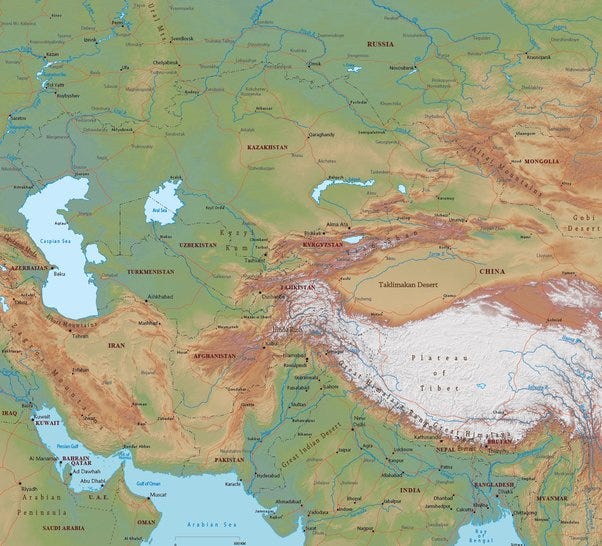How Did Russia Get So Big? (Part 2)
Why did Russia invade Ukraine - Understanding Russia's present day geopolitical goals by studying it's history
This is part 2 of the How Did Russia Get So Big series. You can read part 1 here.
Part 1 ended with Russia securing it’s eastern border. In this post, we will cover Russia’s western expansion as well as how it ties into Russian present day conflict with Ukraine.
Western expansion saw Russia expand over present day Ukraine, Belarus and most of Poland. Russia then pivoted south, spreading towards the Caucasus and conquering the kingdoms of Armenia and Georgia.
Their period of conquest ended once they conquered central Asia, believing that if they don’t do it, Great Britain will.
One gets the impression Russia’s expansion was almost effortless, without any serious pushback. How can this be?
Mostly it come down to geography. Russia expanded into sparsely populated territories. In those days, expanding your empire simply meant reaching some territory and placing your flag (Insert Eddie Izzard bit). If there was no one to oppose your rule, you basically owned that land. So after solving the Mongol problem, Russia pretty much had an unopposed path all the way to the Pacific which it reached in 1633.
In their expansion to the Pacific, they mostly encountered nomads and herders who only wanted to be left alone, be it as part of the Russian or some other empire. It made no difference to the herders.
In the west and south-west Russian was able to take a large part of territory formally belonging the Ottoman empire, weakened from it’s war with the central European powers.
In fact, Russian waged a grand total of 11 wars (over a period of 300 years) against the Ottoman empire, methodically taking over its territories.
The early 18th century saw a conflict between Russian and Sweden where Russian conquered the Baltic area (present day Estonia, Latvia and Lithuania). Later, in the 19th century, Russia took Finland form Sweden. As with the Ottoman empire, Russian fought a total of 11 wars against Sweden, ending Sweden’s status as a regional superpower.
In the first half of the 19th century, the Russian Empire won the Russian – Persian war, gaining them Azerbaijan, Uzbekistan, Kazakhstan and Turkmenistan.
In 1860 they even go to war against the Chinese Qing empire conquering Manchuria.
So to summarize, the history of Russian can be seen as a constant cycle of waging war and preparing for the next war. The question remains to what end? World domination?
The answer differs based on who you ask. While the main imperative of every empire is to grow and expand, in Russia’s case it is just a continuation of the policies of Ivan the Terrible – Russia must expand its borders until it reaches natural barriers able to stop an invasion.
If we look at Russian territory today, this goal has mostly been fulfilled.
In the south Russia stretches to the Carcasses, protecting it from potential middle eastern threats. In central Asia it has reached the mountains Elbrus and Tian Shan, protecting it from Iran and China.
Southern natural barriers
In the east, Russia has reached the Pacific, defending it from China and Japan.
And finally, in the west it reached the Carpathian Mountains and the Black Sea. At one point after WW2 it even held a part of Germany, using it as a buffer zone against France and Britain (even the US).
So was this enough for Russia? As a rule empires want to expand, there is always something more to conquer.
To conclude, in the case of Russia there exist a centuries old idea – One that, in order to be safe, Russia has to be “wedged” between large natural barriers. However, the fall of the USSR saw a dissolution of this idea. Today, Russian views the vast planes in its borderlands in the same way as the Moscow duchy of old did, aware that it is only a mater of time until horsemen show up on the horizon.
From this perspective, Ukraine was always viewed as a threat. A large unconquered plain allowing potential invaders to enter Russian unchecked. Only now they wouldn’t be horseman but armored divisions rolling into Russia.
This is why the prospect of Ukraine joining NATO presents an unacceptable threat to Russia’s national security, and why Russia will do whatever it can to prevent that scenario. Any end of hostilities in Ukraine will probably include a guarantee that Ukraine will remain neutral.

